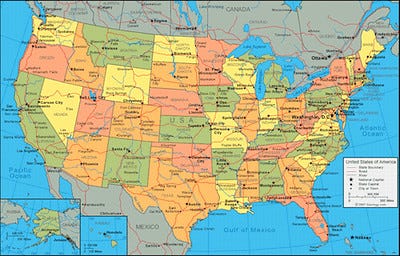#19: CIVICS 101: The Legislative Branch
Q&A #19: Who defines the congressional districts-the Federal Government or the States?
Our American Government
Our American Government is a small book published by the House of Representatives for citizens and those who seek a greater understanding of the American interpretation of democracy. It follows a question-and-answer format and covers a broad range of topics dealing with the three branches of our Government, the electoral process, and the role of political parties.
The Savvy Citizen is reproducing the 169 questions-and-answers through a series of posts called Civics 101. Each post will contain the Q&A as well as some additional commentary to add historical context, fun facts, or anything we believe will add to our collective understanding of these topics.
Think of it as your adult Civics class, but without the test!
Let’s keep at it.
SECTION: The Legislative Branch: The Congress
Members, Offices, and Staff
Q&A #19: Who defines the congressional districts-the Federal Government or the States?
Congress fixes the size of the House of Representatives, and the procedure for apportioning the number of Representatives among the States, and the States themselves proceed from there. State legislatures pass laws defining the physical boundaries of congressional districts, within certain constraints established by Congress and the Supreme Court (through its reapportionment and redistricting rulings). Each State is apportioned its number of Representatives by means of the Department of Commerce’s decennial census.
In the very early years of the Republic, most States elected their Representatives at large. The practice of dividing a State into districts, however, was soon instituted. Congress later required that Representatives be elected from “districts composed of a contiguous and compact territory,” but this requirement is no longer in Federal law.
The redistribution process has always been provided for by State law, but Congress can choose to exercise greater authority over redistricting. In 1967, for example, Congress by law prohibited at large elections of Representatives in all States entitled to more than one Representative. Today, all States with more than one Representative must elect their representatives from single-Member districts.
My Thoughts
With each election cycle, there are usually calls to abolish the Electoral College as an “old and antiquated” institution, looking instead for an “at large” election where the national popular determines the outcome of Presidential elections.
An “at-large” election is one that represents and entire jurisdiction, i.e. city, county, state, nation, and everyone who lives in that jurisdiction (and who is eligible to vote) casts votes in elections. The winner is always determined by a simple majority (50% + of the votes).
If we elected U.S. Presidents via an “at-large” election representing the whole country as a single jurisdiction, all minority voices would be drowned out by the majority every single time. This is how it’s done in pure democracies (none of which exist today) and is the fast lane to tyranny. Representative democracy, on the other hand, ensures that that minority votes aren’t cast aside, but remain represented as well. This is how the United States proclaims “liberty for all,” not just some. Liberty is unique in that it always protects the minority position.
By their very nature, “at-large” elections always produce wins for the majority voting blocs, whether determined by geography, ethnicity, ideology, etc. To ensure that the minority, or smaller, voting blocs are represented, “at-large” jurisdictions must be divided into smaller jurisdictions, or electoral districts, such as cities, counties, and states. Representatives from each of the smaller electoral districts cast votes in the next level of electoral district. Smaller electoral districts usually have differing geographies, ethnicities, concerns— interests of urban dwellers are often different from rural communities—so it’s extremely important that each receives an equal voice.
I mention this since those who seek to abolish the Electoral College during Presidential election cycles are only interested in changing how the President is elected (from representation to majority popular vote), but not how Congressional Representatives and Senators are elected (always through representation). This is worth noting and paying attention to!
Remember, the United States is a Constitutional Republic, not a pure democracy, and it’s imperative that we honor the structure of a Republic to ensure we can keep it. It’s not perfect, nothing is, but it was at the time of the founding and still remains today, the most effective form of self-governance in human history.
—
Back next time with Q&A #20: What is a Member of Congress?
Meanwhile, don’t forget that we’re organizing the post links on a single page available here.
xo,
Kelley for the Savvy Citizen Team
November 18, 2024






